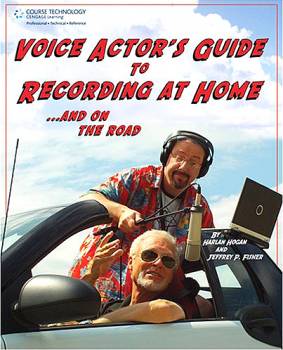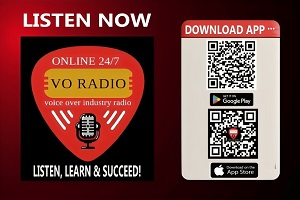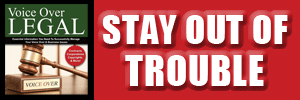|
Part 1: A to L ...
The Glitzy, Ditzy Home Recording
Studio GLOSSARY - Learn & Laugh!
 This glossary is reprinted with permission from the Voice Actor's Guide to Recording At Home ... And On The Road - a soup-to-nuts guide to creating an inexpensive but professional-sounding recording studio in your home or on the road - with lots of laughs! Co-author and voice-over legend Harlan Hogan is also the inventive creator of the Voiceover Essentials online store. This glossary is reprinted with permission from the Voice Actor's Guide to Recording At Home ... And On The Road - a soup-to-nuts guide to creating an inexpensive but professional-sounding recording studio in your home or on the road - with lots of laughs! Co-author and voice-over legend Harlan Hogan is also the inventive creator of the Voiceover Essentials online store.By Harlan Hogan and Jeffrey P. Fisher
A glitzy, glowing, glimmering, glamorous – glossary! Our oh-so-handy guide to arcane audio terminology for posturing, posing, pontification pundits.
A to L
A-B
1. Listening and comparing two or more music, sound effects, or voice-over takes.
2. Letters not appearing on any of Harlan’s report cards.
Acoustics
1. The art and science of controlling sound in a space (acoustics).
2. Branch or twig of a tree where the species Zenaida macroura (mourning doves) perch and make that un-Godly cooing sound.
AES
1. Audio Engineering Society – Meetings feature tuna sandwiches, fries and cash bar. Membership includes personalized pocket protector.
2. American Egotistical Society – Meetings feature All-You-Can-Stand buffet and open bar. Membership includes custom-fit earplugs for the networking meet-eat-greet portion of the program.
Ambience
1. Room acoustics, reflections and reverberation. In essence, the audible sound of any room or environment, sometimes called room tone.
2. Fast moving, siren-bedecked emergency vehicle.
Amplification
1. The process that increases signal strength of an audio source, i.e. boosting the low level signal from a mic to be loud enough to hear through a loudspeaker.
2. To re-explain/reiterate, as in: "What portion of NO don't you understand?”
Analog
1. Short for analogous. A fancy way of saying something is like something else. For example, electricity from a microphone is like (analogous/analog) the sound waves that strike it. Regular (non computer) audio sounds are called analog versus digital audio when you get your computer involved.
2. To build a roaring fire you’ll need kindling, a match, an-a-log.
Analog-to-Digital (A/D) Converter
1. A device that converts analog audio signal into digital data (1s & 0s) and back again (digital-to-analog converter).
2. The major component in an audio interface or sound card.
3. Adderall, Ritalin and Dexedrine are often prescribed as Attention Deficit Converters.
Assign
1. To route or send an audio signal to one or more selected channels.
2. Graduation requirement Mr. Hogan consistently failed to complete, forcing him into a life as an itinerant actor trodding the boards, hat in hand.
3. Spiritual encounter indicating a necessary change in one’s life - because you've screwed up and God was watching.
Attack
1. The beginning of a sound.
2. Popular political advertising genre.
Attack Time
1. When using a compressor to process audio signals, this is the time it takes for a reduction in gain (volume) to happen.
2. Decision to use popular political advertising genre.
Attenuate
1. Reduce or lower the level (volume) of an audio signal.
2. Response to question: "What time did I dine last night?”
Balance
1. The relative volume levels and placement of audio elements in a recording.
2. Lifestyle – wherein real people don’t talk like this.
Balanced Line
1. A cable with two conductors surrounded by a shield, in which each conductor is at equal impedance to ground. The cable's conductors are at opposite polarity, and the signal flows through both conductors. Balanced lines help reject noise
2. Conversation starter which includes even a feigned degree of interest in another person. For instance, "Say, isn’t that a patch cord in your pocket? Tip, ring, sleeve? Wow! that’s my favorite, too!”
Bass Trap
1. An acoustic array which absorbs low-frequency sound waves in the studio.
2. A much-underestimated way to feed the family with fresh-caught, freshwater fish.
Bus
1. Large vehicle used to spoil America’s youth - Jeffrey, for example. He never had to march through waist-high snow, ford turgid torrents of ankle-deep water, or run in Forest Gump terror from tornado-infested winds on the way to school like Harlan did. This explains a lot.
2. A common wire connecting a group of signals together – kind of the equivalent of USB, only with audio gear. Did you know USB stands for Universal Serial BUS? Yep!
Bus Master
1. The Grand Poohbah control of the audio zooming along the bus, this fader controls the output volume of all the signals on the bus master.
2. Jackie Gleason.
Buzz
1. An unwanted edgy tone that sometimes accompanies audio, containing high harmonics of 60Hz.
2. Woody’s antagonist in Toy Story.
Cans
1. Slang for headphones.
2. Our pronunciation of that ritzy film festival we’ll never get invited to.
Cardiod Microphone
1. A microphone with a one-sided heart-shaped directional pattern. Sound arriving at the rear of the microphone is much lower in volume. Therefore, these mics tend to reject more room noise and give a more in-your-face vocal sound.
2, The mic most VOs use.
CD-R and CD-RW
1. CD-Rs are recordable compact discs that can't be erased and reused, while CD-RWs are the opposite.
2. RD-D2’s second cousins.
Cellular Buzz (GSM Noise)
1. The sound that gets inadvertently recorded when you leave your cell phone on.
2. See also Angry Engineer.
3. See also Really Angry Engineer.
Complex Wave
1. A sound wave containing more than one frequency or harmonics.
2. Hairstyles, often involving extenders, curling irons and weaves.
Compressor
1. A signal processor that reduces the dynamic range of an audio gain using an automatic volume control. The result is that louder sounds are lowered to the level of softer sounds. This allows the whole file to be raised in volume.
2. Super-fast Germanic automobiles zipping down the Autobahn.
Condenser Microphone
A microphone that uses variable capacitance to generate its electrical signal. Condensers require external power to operate. See also Phantom Power.
Connector
1. Devices used to connect a cable and an electronic component or between two cables, so that signals can flow from one to the other.
2. Yente, the matchmaker in Fiddler on the Roof.
DAT (R-DAT)
1. A digital audio tape recorder.
2. Popular New Jersey query: "Who R Dat dere?”
Digital Audio Workstation (DAW)
1. A combination of a computer, sound card, and editing software that let’s us record, edit, and mix, and deliver audio programs entirely in digital form.
2. Abbreviation for Daughters of the American Workforce.
Decay
1. The declining end of a sound or musical note over time.
2. Corollary result of failed flossing and botched brushing.
Decibel (dB)
1. Logarithmic scale for measuring audio level, with 0dB being the threshold of hearing, and 120dB the threshold of pain.
2. Abbreviation for Dead Beat. See also Actor, Itinerant.
De-Esser
1. An audio processing device that removes excessive sibilance (s and sh sounds) by detecting it and then reducing the sibilance volume automatically. A de-esser is, in essence, a frequency-controlled compressor.
2. Ice removal techniques used by most major airlines
Desk
1. The British term for mixing console/mixing board.
2. The British are weird.
Destructive Editing
1. Editing that rewrites data on a hard drive permanently so edits cannot be undone.
2. Terrifying technique of our own, much-feared Prunella Sykes.
Diffusion
1. An even distribution of sound in a room.
2. Fusion that makes a difference.
Distortion
1. Any unwanted change in the audio waveform. It may be accompanied by a nasty, raspy, or gritty sound quality. The appearance of frequencies in a device's output signal that were not in the input signal. Distortion is caused by recording at too high a level, improper mixer settings, components failing, or vacuum tubes distorting. (Distortion can be desirable for some instances, such as a distorted electric guitar in the Heavy Metal music Harlan drifts off to most evenings about 9:30.)
2. Another popular political advertising genre.
3. Lies! I’m tellin’ ya’ It’s all lies!
Dry
1. Recorded tracks that have not yet had any signal processing applied to them.
2. Recorded tracks with no music or sound effects.
3. Ephraim, Wisconsin.
Dynamic Microphone
1. A microphone that generates its own electricity when sound waves cause a moving coil to vibrate within a magnetic field.
2. She was slim, trim and on-so-powerful. One look and Jeffrey knew this was one dynamic mic. Now, where could he hide her from Lisa?
Dynamic Range
1. The range of recorded volume levels softest to loudest, i.e. the range of a whisper to a shout.
2. Although not as popular as the ubiquitous microwave, dynamic ranges are being embraced by many of the world’s top chefs.
Echo
1. The delayed and distinct repetition of a sound. If you shout "hello" into a canyon, you'll hear "hello, hello, hello, hello" repeating.
2. Little Sir’s last name.
Echo Chamber
1. The British name for a physical echo chamber consisting of a hard-surfaced room with a widely separated loudspeaker and microphone to create and record reverberation. The Brits call reverb "echo" and the American’s call reverb, uh, "reverb," and then we call echo, "delay." Weird, eh?
2. Electronic echo chambers can be hardware or software based.
3. The legendary movie sound effect, dubbed the Wilhelm Scream, was enhanced with echo chambers since first being heard in the 1951 B-movie Distant Drums. Since then, the scream has found it’s way into over 300 video games, commercials and movies from Star Wars and Raiders of the Lost Ark, to Batman Returns and Toy Story. Who says Hollywood isn’t green? They have been recycling this for a long, long time.
Editing
1. Originally, physically cutting and taping together magnetic tape to delete or rearrange audio.
2. Today, editing is done using computers without cutting any tape or your fingers.
Effects
1. Sound changing/enhancing effects like equalization, reverberation, echo/delay, flanging, chorusing, compression, de-essing, noise gate, etc.
2. See last.
Equalization (EQ)
1. You know those tone controls you fiddle with in your car to adjust the bass and treble? Yeah, well that’s the same as EQ, but tone control sounds so ... pedestrian, and it’s hard to bill studio time for that.
2. The adjustment of frequency response to alter the tonal balance or to eliminate/reduce unwanted frequiencies.
Expander
1. A signal processing device or software that increases the dynamic range of audio through it.
2. Clever clothing invention introduced in 1959 by the Jaymar-Ruby company of Michigan City, Indiana. The Sansbelt comfort-fit waistband allowed gentlemen to subtly "adjust” one’s trouser’s waist size without anyone being the wiser.
Fade Out
1. To gradually reduce the volume of the last several seconds of a recorded song, from full level down to silence, by slowly pulling down the master volume fader.
2. See also Career, Hogan
Fader
1. A rotating or sliding volume control used to adjust signal levels.
2. In da Bronx you've got a Mudder and one of these.
Feedback
1. That ear-piercing squealing sound heard when a microphone picks up its own amplified signal through a loudspeaker.
2. An even more ear-piercing sound when feedback involves your headphones.
3. Unsolicited critique of your performance.
Flutter
1. A rapid, periodic variation in pitch usually caused by uneven tension between the tape reels in analog recording.
2. Jeffrey’s heartbeat when he finds the latest edition of Electronic Musician magazine in his mailbox.
Frequency
1. The number of cycles per second of a sound wave, measured in hertz (Hz).
2. Think of - and be depressed - by the corollary.
Gain
1. Amplification or volume.
2. See Ill-gotten.
3. See also Residual.
Gate (Noise Gate)
1. Software or hardware that turns off a signal when its amplitude falls below a preset level.
2. Device used to keep wanna-bees and fans at a distance from Mr. Fisher's and Mr. Hogan’s mansions.
Ground Loops
1. A hum result form having morethan one grounding point in an electronic connection.
2. Bi-plane wannabees in the late 1920’s who, though afraid to actually take off, still managed to entertain the crowd.
Harmonic(s)
1. An overtone whose frequency is a whole-number multiple of the fundamental frequency. For comparison, an octave is a doubling of frequency.
2. Once a very popular musical device due to it’s low cost and portability.
Headroom
1. The safe zone (measured in decibels) between the average signal level and the maximum undistorted signal level.
2. Area (measured in inches) between forehead and ceiling.
Hertz (Hz)
1. Cycles per second, the unit of measurement of frequency.
2. Humans hear from 20Hz to 20,000Hz, with the higher numbers reduced with age.
3. Pretty much on a par with Avis. We prefer Enterprise - because you know – they pick us up – and usually we both need picking up.
Hot
1. A high recording or playback level.
2. Equipment that is receiving power.
3. A "live" microphone, i.e. watch what you say.
4. Catherine Zeta-Jones, Jennifer Love Hewitt, Scarlett Johansson, Jessica Biel
5. The two L’s - Lisa and Lesley, our wives.
6. Really.
Hum
1. Low-pitched tone (usually around 60Hz) generated in audio circuits and cables by alternating current due to faulty grounding, poor shielding, and ground loops.
2. Way of re-creating music without the need of costly instruments or lyrics.
Input
1. The signal going into an audio device, usually through a connector for a microphone, or other signal source.
2. Advice and opinions, usually unsolicited. See also Feedback.
Insert Jacks
1. Special jacks that allow you to insert effects, such as reverberation, directly into your audio from other (outboard) processing gear.
2. Dangerous technique to cheat in Texas Hold 'Em.
Leakage
1. Unwanted audio bleeding onto a track, frequently due to headphones being too loud or loose-fitting.
2. We refuse to do some sophomoric joke about Depends. Nope, not us.
LED Indicator
1. A recording-level indicator using one or more Light Emitting Diodes.
2. Electronic device the EPA uses to find toxins in paint.
Level
The degree of intensity of an audio signal.
Limiter (Peak Limiter)
1. A signal processor whose output stays the same above a preset "never to be exceeded” input level.
2. Overbearing parent.
Line Level
1. In balanced professional recording equipment, a signal whose level is approximately minus 4dBv.
2. Relative overall height of high-kicking dance troupe.
Loop
1. In a software sampling program, repeating loops of audio can be combined to create music.
2. Encircled by the Chicago Transit Association’s elevated trains.
Loudspeaker
1. Device (transducer) that converts electrical energy (the signal) into acoustical energy (sound waves).
2. Jesse Jackson.
Lowpass Filter
1. A hardware or software filter that allows frequencies below a certain frequency through, but stops frequencies above that same frequency.
2. The opposite is a high-pass filter.
3. Warning device required by the Interstate Commerce Commission on semi-trailer trucks.
See Part 2: Definitions M to Y
For more about all home studio topics, check out the The Voice Actor’s Guide to Recording at Home & On the Road, 2nd Edition.
ABOUT HARLAN & JEFFREY ...
Harlan Hogan has been voice acting for more than 30 years, giving voice to many recognizable ad campaigns, including, "It’s the cereal even Mikey likes,” and "Hey Culligan Man!” He’s also heard on countless documentaries and is the familiar voice on PBS saying, "This program is made possible by … Thank you.” Based near Chicago, he is also author of VO: Tales and Techniques of a Voice-Over Actor.
Email: harlan@harlanhogan.com
Web: www.harlanhogan.com
Store: Voiceover Essentials
Jeffrey P. Fisher is an award-winning and in-demand sound engineer, instructor of sudio and video production and post production, the author of 11 books, and specializes in digital content creation, including words, music, sound and visuals. He works form his Illinois project studio on a variety of music, writing and multimedia products.
Email: jpf@jeffreypfisher.com

Your Daily Resource For Voice-Over Success
|
Tell Us What YOU Think!
Please Note: Since we check for spam, there will be a slight delay in the actual posting of your comment.
Comments (3)
Scott Carr
8/23/2010 at 7:50 PM
Well done - now I'm ready to rock! I liked the one with R2D2 (nice CYA on the HOT one).
George Whittam
8/23/2010 at 2:19 PM
Edu-tainment at it's best! Love it, Harlan ...
Linda Ristig
8/23/2010 at 8:38 AM
This was an educational and entertaining way to begin the morning, guys! Let me guess, was it Jeffrey that created the technical definitions, and Harlan, were you the one that went in a completely different and fun direction? Loved the an-a-log joke. See #2 Analog. Thanks a lot ... now it's stuck in my brain! Nice job on the glossary, gentlemen!





.png)



click for new article alerts